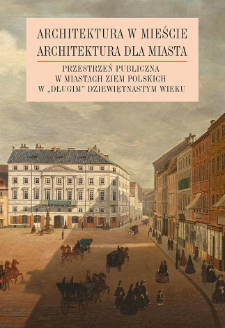
Object
Title: Piękno miasta i przestrzenie reprezentacyjne w projektach konkursowych na Wielki Kraków
Subtitle:
The city’s beauty and representative spaces in the design competition for Great Kraków ; Architektura w mieście, architektura dla miasta : przestrzeń publiczna w miastach ziem polskich w "długim" dziewiętnastym wieku ; Zabór austriacki
Contributor:
Łupienko, Aleksander (1980– ) : Editor ; Zabłocka-Kos, Agnieszka (1957– ) : Editor ; Polska Akademia Nauk. Instytut Historii im. Tadeusza Manteuffla
Publisher:
Place of publishing:
Description:
p. 189-218 : ill. (some color) ; 24 cm ; Abstract in English
Type of object:
Abstract:
The architectural competition held in 1910 to design a “Great Kraków” was undoubtedly the most important event in Polish urban planning before 1918. It is not without reason that it was regarded as one of the breakthroughs, marking the beginnings of the “modern” rebuilding of Polish cities. At the same time, it inscribed to a longer worldwide chain of events related to urban planning “around the year 1910”, that included, among others, competitions for “Great Copenhagen” (1908–1909), “Great Berlin” (1909–1910), the plan of Chicago by Daniel Burnham and Edward H. Bennett (1909), and the competition for a plan of Canberra (1912). Despite its great significance, the Kraków competition has however not been thoroughly researched yet, especially regarding the designs that did not win awards, by Sylwester Pajzderski, and those that were purchased, by Ignacy Drexler and Juliusz Oleś with Szymon Weinberg. This article, while not pretending to exhaust the entire breadth and depth of the Kraków competition and submitted projects, focuses on the way in which the idea of Stadtbaukunst, the art of city building—such an important factor of urban planning theory at the end of the nineteenth and the early twentieth centuries—was reflected in these projects, together with the question of what constituted a “beautiful city”. There is no doubt that the ideas were mirrored in the competition designs, as they were also echoed in the competition programme. However, it was not always that the pursuit of making “beautiful Kraków” was compatible with the demands of the art of city building; often the participants postulated transformations, at times quite significant ones, of the historic substance of the city. Nevertheless, none of the designs presented a concrete vision of the coherent, mainly symbolic identity of the future “Great Kraków”. The participants seemed to have focused their attention mainly on attempts to transform Kraków into a healthy and convenient city to live in; thus, to direct it towards modernity.
Start page:
End page:
Detailed Resource Type:
Resource Identifier:
oai:rcin.org.pl:140639 ; 978-83-65880-53-6
Source:
IH PAN, call no. II.14682 ; IH PAN, call no. II.14681 Podr. ; click here to follow the link
Language:
Language of abstract:
Rights:
Creative Commons Attribution BY-ND 4.0 license
Terms of use:
Copyright-protected material. [CC BY-ND 4.0] May be used within the scope specified in Creative Commons Attribution BY-ND 4.0 license, full text available at: ; -
Digitizing institution:
Institute of History of the Polish Academy of Sciences
Original in:
Library of the Institute of History PAS
Access:
Object collections:
- Digital Repository of Scientific Institutes > Partners' collections > Institute of History PAS > Books
- Digital Repository of Scientific Institutes > Partners' collections > Institute of History PAS > Institute Publications
- Digital Repository of Scientific Institutes > Partners' collections > Institute of History PAS > Institute Publications > Books
- Digital Repository of Scientific Institutes > Literature > Books/Chapters
Last modified:
Oct 2, 2020
In our library since:
Sep 23, 2020
Number of object content downloads / hits:
647
All available object's versions:
https://rcin.org.pl./publication/175607
Show description in RDF format:
Show description in RDFa format:
Show description in OAI-PMH format:
| Edition name | Date |
|---|---|
| Kiecko, Emilia, Piękno miasta i przestrzenie reprezentacyjne w projektach konkursowych na Wielki Kraków | Oct 2, 2020 |
Objects Similar
Kozińska-Witt, Hanna
Twardowska, Kamila
Łupienko, Aleksander (1980– )
Łupienko, Aleksander (1980– ) Zabłocka-Kos, Agnieszka (1957– )
Makała, Rafał (1967– )

 INSTYTUT ARCHEOLOGII I ETNOLOGII POLSKIEJ AKADEMII NAUK
INSTYTUT ARCHEOLOGII I ETNOLOGII POLSKIEJ AKADEMII NAUK
 INSTYTUT BADAŃ LITERACKICH POLSKIEJ AKADEMII NAUK
INSTYTUT BADAŃ LITERACKICH POLSKIEJ AKADEMII NAUK
 INSTYTUT BADAWCZY LEŚNICTWA
INSTYTUT BADAWCZY LEŚNICTWA
 INSTYTUT BIOLOGII DOŚWIADCZALNEJ IM. MARCELEGO NENCKIEGO POLSKIEJ AKADEMII NAUK
INSTYTUT BIOLOGII DOŚWIADCZALNEJ IM. MARCELEGO NENCKIEGO POLSKIEJ AKADEMII NAUK
 INSTYTUT BIOLOGII SSAKÓW POLSKIEJ AKADEMII NAUK
INSTYTUT BIOLOGII SSAKÓW POLSKIEJ AKADEMII NAUK
 INSTYTUT CHEMII FIZYCZNEJ PAN
INSTYTUT CHEMII FIZYCZNEJ PAN
 INSTYTUT CHEMII ORGANICZNEJ PAN
INSTYTUT CHEMII ORGANICZNEJ PAN
 INSTYTUT FILOZOFII I SOCJOLOGII PAN
INSTYTUT FILOZOFII I SOCJOLOGII PAN
 INSTYTUT GEOGRAFII I PRZESTRZENNEGO ZAGOSPODAROWANIA PAN
INSTYTUT GEOGRAFII I PRZESTRZENNEGO ZAGOSPODAROWANIA PAN
 INSTYTUT HISTORII im. TADEUSZA MANTEUFFLA POLSKIEJ AKADEMII NAUK
INSTYTUT HISTORII im. TADEUSZA MANTEUFFLA POLSKIEJ AKADEMII NAUK
 INSTYTUT JĘZYKA POLSKIEGO POLSKIEJ AKADEMII NAUK
INSTYTUT JĘZYKA POLSKIEGO POLSKIEJ AKADEMII NAUK
 INSTYTUT MATEMATYCZNY PAN
INSTYTUT MATEMATYCZNY PAN
 INSTYTUT MEDYCYNY DOŚWIADCZALNEJ I KLINICZNEJ IM.MIROSŁAWA MOSSAKOWSKIEGO POLSKIEJ AKADEMII NAUK
INSTYTUT MEDYCYNY DOŚWIADCZALNEJ I KLINICZNEJ IM.MIROSŁAWA MOSSAKOWSKIEGO POLSKIEJ AKADEMII NAUK
 INSTYTUT PODSTAWOWYCH PROBLEMÓW TECHNIKI PAN
INSTYTUT PODSTAWOWYCH PROBLEMÓW TECHNIKI PAN
 INSTYTUT SLAWISTYKI PAN
INSTYTUT SLAWISTYKI PAN
 SIEĆ BADAWCZA ŁUKASIEWICZ - INSTYTUT TECHNOLOGII MATERIAŁÓW ELEKTRONICZNYCH
SIEĆ BADAWCZA ŁUKASIEWICZ - INSTYTUT TECHNOLOGII MATERIAŁÓW ELEKTRONICZNYCH
 MUZEUM I INSTYTUT ZOOLOGII POLSKIEJ AKADEMII NAUK
MUZEUM I INSTYTUT ZOOLOGII POLSKIEJ AKADEMII NAUK
 INSTYTUT BADAŃ SYSTEMOWYCH PAN
INSTYTUT BADAŃ SYSTEMOWYCH PAN
 INSTYTUT BOTANIKI IM. WŁADYSŁAWA SZAFERA POLSKIEJ AKADEMII NAUK
INSTYTUT BOTANIKI IM. WŁADYSŁAWA SZAFERA POLSKIEJ AKADEMII NAUK


































